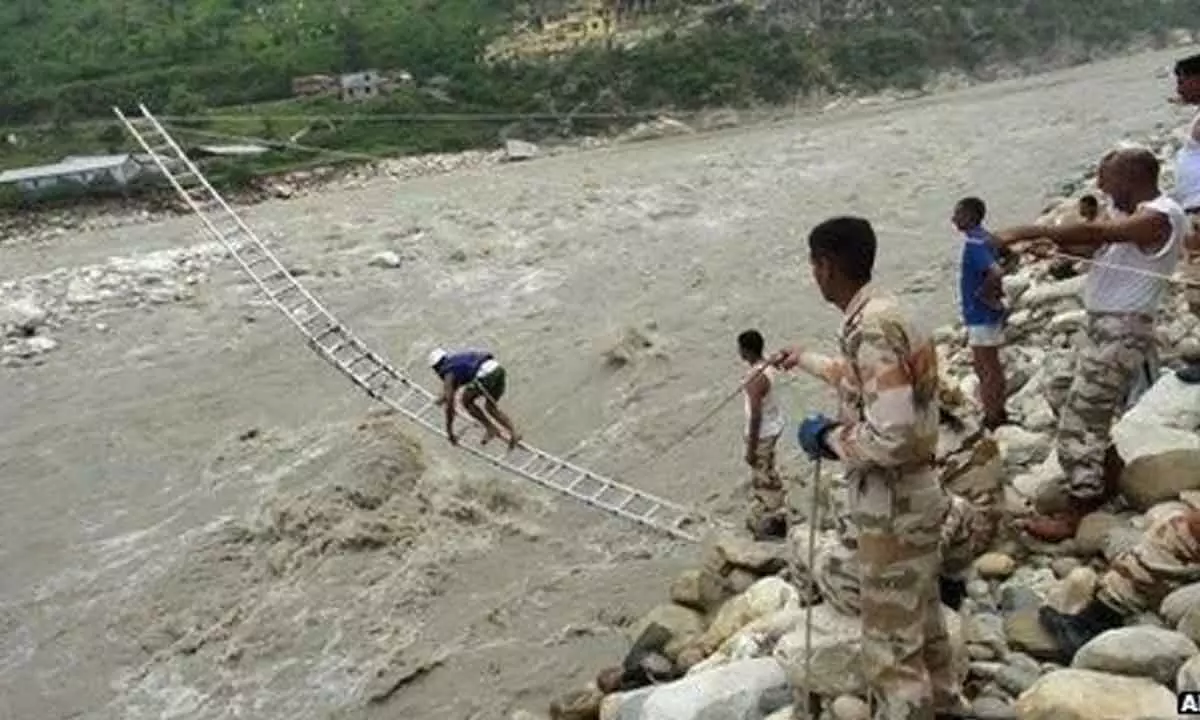Live
- Mahindra Auto sells 41,008 SUVs in India in April, registering 18 pc growth
- Pitch for India vs Pakistan ICC T20 World Cup 2024 match installed
- Playback Singer Uma Ramanan Passes Away
- Omar Abdullah says BJP trying to divide people on religious lines
- Kamakshi Bhaskarla wins Best Actress Jury Award at Dada Saheb Phalke Film Fest 2024
- Akums Drugs launches DCGI-approved meds for treatment of resistant high BP
- Janhvi Kapoor turns host for Sridevi's Chennai home, says it was her 'prized possession'
- CM Stalin cuts short his holiday in Kodaikanal, to return to Chennai today
- Khammam: Congress draws public ire; BRS all set to triumph
- Bopanna-Ebden knocked
Just In
Revisiting Uttarakhand tragedy after a decade


Hyderabad: Uttarakhand experienced its most devastating tragedy in 2013, but unfortunately, it has failed to learn from its past mistakes over the...
Hyderabad: Uttarakhand experienced its most devastating tragedy in 2013, but unfortunately, it has failed to learn from its past mistakes over the decade. The State’s lack of adequate disaster preparedness, haphazard urban development, and insufficient implementation of environmental regulations demonstrate a disregard for the lessons that should have been learned. This negligence puts the lives and safety of its residents at risk once again.
According to the UN Office for Disaster Risk Reduction, Centre for Research on the Epidemiology of Disasters, report titled, ‘Human cost of disasters: An overview of last 20 years: 2000 to 2019’, the devastating floods claimed 6,054 lives.
Speaking to The Hans India, Himanshu Thakkar, coordinator of South Asia Network on Dams, Rivers and People (SANDRP), an informal network of organizations and individuals working on issues related with water sector, said, “It has been a decade now, yet, Uttarakhand has not taken effective measures to build a robust and strong resilient disaster preparedness mechanism despite facing disasters at regular intervals.”
One of the critical requirements for the State is an adequate number of Doppler radars, which are currently lacking. Presently, there is only one radar system situated in the Institute of Temperate Horticulture campus in Mukteshwar, Nainital district. Doppler radars are essential devices capable of gauging the intensity of precipitation in the air, enabling the prediction of severe weather conditions. To prevent natural disasters, there is an urgent need for a strong and effective prediction mechanism within the State. The devastating 2021 floods in Uttarakhand, known as the Chamoli disaster, and the land subsidence in Joshimath serve as stark reminders of the gravity of the situation.
After the floods in 2013, upon the directions of the Supreme Court of India, the Ministry of Environment and Forests constituted an expert body under the chairmanship of environmentalist Dr Ravi Chopra, to make a detailed study on the assessment of environmental degradation and impact of hydro power projects. Speaking to The Hans India, Dr Ravi Chopra, said, “The State of Uttarakhand finds itself just as vulnerable today as it did a decade ago. The concerning shift in climate patterns and the rise in heavy rainfall activities pose significant risks to this Himalayan region. Among the various recommendations we put forth, one stands out as particularly crucial: learning from the June 2013 event. The Expert Board (EB) strongly believed that the increased availability of sediment from paraglacial zones could pose a severe threat to the sustainability of existing, under construction, and proposed Hydroelectric Projects (HEPs) in Uttarakhand. Therefore, the EB recommended that the areas above the Main Central Thrust (MCT), especially above the winter snow line (~2200-2500 m), should remain free from any hydropower interventions in order to safeguard the region’s long-term stability.” Most of our recommendations have been ignored and it is unfortunate that State is facing immense challenges due to natural and man-made disasters, he added.

© 2024 Hyderabad Media House Limited/The Hans India. All rights reserved. Powered by hocalwire.com






